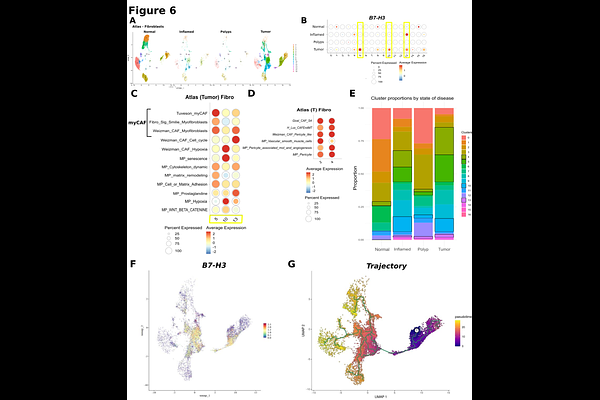Multi-omic analysis of colorectal adenocarcinoma identifies a new subtype of myofibroblastic cancer-associated fibroblast expressing high level of B7-H3 and with poor prognosis value.

Multi-omic analysis of colorectal adenocarcinoma identifies a new subtype of myofibroblastic cancer-associated fibroblast expressing high level of B7-H3 and with poor prognosis value.
Picard, M.; Guille, A.; Finetti, P.; De Rauglaudre, B.; Belfil, N.; Mescam, L.; Birnbaum, D. J.; Bertucci, F.; Mamessier, E.
AbstractThe high mortality rate of colorectal cancer (CRC) combined with the lack of non-toxic and efficient personalized treatments makes it urgent to develop new targeted therapies for this disease. B7-H3 appears to be a good target as it is overexpressed in tumor tissue compared to normal tissue. However, B7-H3 is a molecule with ambivalent functions and is expressed by different cell types. This complexity contributed to the delay in identifying cell subtypes that express B7-H3 and their potential role in colorectal oncogenesis. In this study, we used in silico bulk, single-cell, and spatial transcriptomic data to investigate the clinical and biological characteristics of tumors with high B7-H3 expression, the precise nature of cells expressing high level of B7-H3, and their temporal appearance during colorectal oncogenesis. We found that tumors with high B7-H3 expression corresponded to tumors with a predominant stroma composed mainly of fibroblasts. Among them, two subtypes of ecm-myCAF fibroblasts and pro-fibrotic pericytes specifically expressed high levels of B7-H3, the former being an independent factor for poor prognosis in CRC. Finally, by examining precancerous lesions, we report that fibroblast subtypes with high levels of B7-H3 appear early during oncogenesis, especially at the inflamed stage. We also shed light on the fact that anti-B7-H3 immunotherapies might therefore preferentially target cells from the microenvironment rather than the tumor cells. This is particularly important to understand the mode of action of the anti-B7-H3 antibody-drug conjugate, which is currently being tested in clinical trials in several solid tumors.